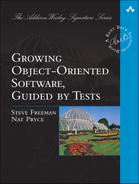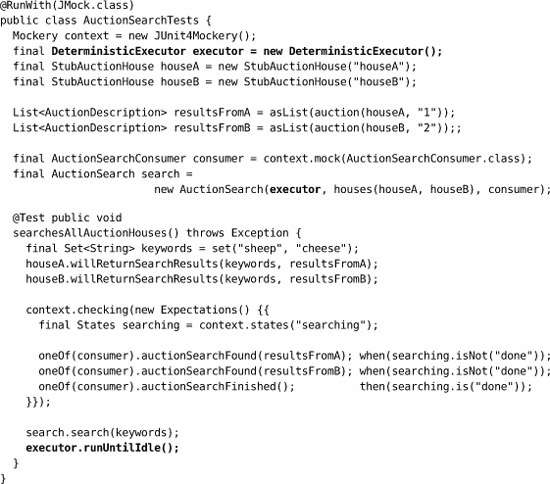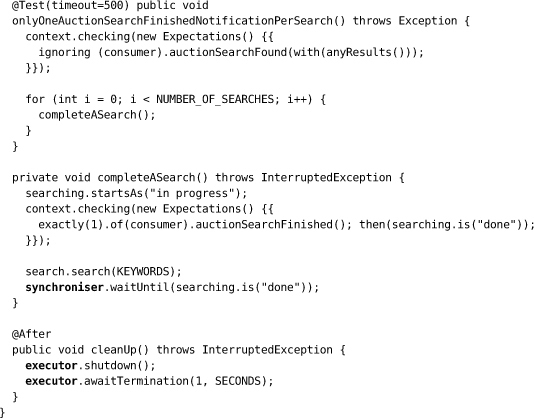Chapter 26. Unit Testing and Threads
It is decreed by a merciful Nature that the human brain cannot think of two things simultaneously.
—Sir Arthur Conan Doyle
Introduction
There’s no getting away from it: concurrency complicates matters. It is a challenge when doing test-driven development. Unit tests cannot give you as much confidence in system quality because concurrency and synchronization are systemwide concerns. When writing tests, you have to worry about getting the synchronization right within the system and between the test and the system. Test failures are harder to diagnose because exceptions may be swallowed by background threads or tests may just time out with no clear explanation.
It’s hard to diagnose and correct synchronization problems in existing code, so it’s worth thinking about the system’s concurrency architecture ahead of time. You don’t need to design it in great detail, just decide on a broad-brush architecture and principles by which the system will cope with concurrency.
This design is often prescribed by the frameworks or libraries that an application uses. For example:
• Swing dispatches user events on its own thread. If an event handler runs for a long time, the user interface becomes unresponsive because Swing does not process user input while the event handler is running. Event call-backs must spawn “worker” threads to perform long-running tasks, and those worker threads must synchronize with the event dispatch thread to update the user interface.
• A servlet container has a pool of threads that receive HTTP requests and pass them to servlets for processing. Many threads can be active in the same servlet instance at once.
• Java EE containers manage all the threading in the application. The container guarantees that only one thread will call into a component at a time. Components cannot start their own threads.
• The Smack library used by the Auction Sniper application starts a daemon thread to receive XMPP messages. It will deliver messages on a single thread, but the application must synchronize the Smack thread and the Swing thread to avoid the GUI components being corrupted.
When you must design a system’s concurrency architecture from scratch, you can use modeling tools to prove your design free of certain classes of synchronization errors, such as deadlock, livelock, or starvation. Design tools that help you model concurrency are becoming increasingly easy to use. The book Concurrency: State Models & Java Programs [Magee06] is an introduction to concurrent programming that stresses a combination of formal modeling and implementation and describes how to do the formal modeling with the LTSA analysis tool.
Even with a proven design, however, we have to cross the chasm between design and implementation. We need to ensure that our components conform to the architectural constraints of the system. Testing can help at this point. Once we’ve designed how the system will manage concurrency, we can test-drive the objects that will fit into that architecture. Unit tests give us confidence that an object performs its synchronization responsibilities, such as locking its state or blocking and waking threads. Coarser-grained tests, such as system tests, give us confidence that the entire system manages concurrency correctly.
Separating Functionality and Concurrency Policy
Objects that cope with multiple threads mix functional concerns with synchronization concerns, either of which can be the cause of test failures. Tests must also synchronize with the background threads, so that they don’t make assertions before the threads have finished working or leave threads running that might interfere with later tests. Worse, in the presence of threads, unit tests do not usually report failures well. Exceptions get thrown on the hidden threads, killing them unexpectedly and breaking the behavior of the tested object. If a test times out waiting for background threads to finish, there’s often no diagnostic other than a basic timeout message. All this makes unit testing difficult.
Searching for Auctions Concurrently
Let’s look at an example. We will extend our Auction Sniper application to let the user search for auctions of interest. When the user enters search keywords, the application will run the search concurrently on all auction houses that the application can connect to. Each AuctionHouse will return a list of AuctionDescriptions that contain information about its auctions matching the search keywords. The application will combine the results it receives from all AuctionHouses and display a single list of auctions to the user. The user can then decide which of them to bid for.
The concurrent search is performed by an AuctionSearch object which passes the search keywords to each AuctionHouse and announces the results they return to an AuctionSearchConsumer. Our tests for the Auction Search are complicated because an AuctionSearch will spawn multiple threads per search, one for each AuctionHouse. If it hides those threads behind its API, we will have to implement the searching and notification functionality and the synchronization at the same time. When a test fails, we will have to work out which of those concerns is at fault. That’s why we prefer our usual practice of incrementally adding functionality test by test.
It would be easier to test and implement the AuctionSearch if we could tackle the functional behavior and the synchronization separately. This would allow us to test the functional behavior within the test thread. We want to separate the logic that splits a request into multiple tasks from the technical details of how those tasks are executed concurrently. So we pass a “task runner” in to the AuctionSearch, which can then delegate managing tasks to the runner instead of starting threads itself. In our unit tests we’ll give the AuctionSearch a fake task runner that calls tasks directly. In the real system, we’ll give it a task runner that creates threads for tasks.
Introducing an Executor
We need an interface between the AuctionHouse and the task runner. We can use this one from Java’s standard java.util.concurrent package:
![]()
How should we implement Executor in our unit tests? For testing, we need to run the tasks in the same thread as the test runner instead of creating new task threads. We could use jMock to mock Executor and write a custom action to capture all calls so we can run them later, but that sounds too complicated. The easiest option is to write a class to implement Executor. We can use it explicitly to run the tasks on the test thread after the call to the tested object has returned. jMock includes such a class, called DeterministicExecutor. We use this executor to write our first unit test. It checks that AuctionSearch notifies its AuctionSearchConsumer whenever an AuctionHouse returns search results and when the entire search has finished.
In the test setup, we mock the consumer because we want to show how it’s notified by AuctionSearch. We represent auction houses with a simple StubAuctionHouse that just returns a list of descriptions if it matches keywords, or an empty list if not (real ones would communicate to auction services over the Internet). We wrote a custom stub, instead of using a jMock allowance, to reduce the “noise” in the failure reports; you’ll see how this matters when we start stress-testing in the next section. We also pass an instance of DeterministicExecutor to AuctionSearch so that we can run the tasks within the test thread.
In the test, we configure the StubAuctionHouses to return example results when they’re queried with the given keywords. We specify our expectations that the consumer will be notified of the two search results (in any order), and then that the search has finished.
When we call search.search(keywords), the AuctionSearch hands a task for each of its auction houses to the executor. By the time search() returns, the tasks to run are queued in the executor. Finally, we call executor.runUntilIdle() to tell the executor to run queued tasks until its queue is empty. The tasks run on the test thread, so any assertion failures will be caught and reported by JUnit, and we don’t have to worry about synchronizing the test thread with background threads.
Implementing AuctionSearch
This implementation of AuctionSearch calls its executor to start a search for each of its auction houses. It tracks how many searches are unfinished in its runningSearchCount field, so that it can notify the consumer when it’s finished.

Unfortunately, this version is unsafe because it doesn’t synchronize access to runningSearchCount. Different threads may overwrite each other when they decrement the field. So far, we’ve clarified the core behavior. We’ll drive out this synchronization issue in the next test. Pulling out the Executor has given us two advantages. First, it makes development easier as we can unit-test the basic functionality without getting confused by threading issues. Second, the object’s API no longer hides its concurrency policy.
Concurrency is a system-wide concern that should be controlled outside the objects that need to run concurrent tasks. By passing an appropriate Executor to the constructor, we’re following the “context independence” design principle. The application can now easily adapt the object to the application’s threading policy without changing its implementation. For example, we could introduce a thread pool should we need to limit the number of active threads.
Unit-Testing Synchronization
Separating the functional and synchronization concerns has let us test-drive the functional behavior of our AuctionSearch in isolation. Now it’s time to test-drive the synchronization. We will do this by writing stress-tests that run multiple threads through the AuctionSearch implementation to cause synchronization errors. Without precise control over the thread scheduler, we can’t guarantee that our tests will find synchronization errors. The best we can do is run the same code enough times on enough threads to give our tests a reasonable likelihood of detecting the errors.
One approach to designing stress tests is to think about the aspects of an object’s observable behavior that are independent of the number of threads calling into the object. These are the object’s observable invariants with respect to concurrency.1 By focusing on these invariants, we can tune the number of threads in a test without having to change its assertions. This gives us a process for writing stress tests:
1. This differs from the use of invariants in “design by contract” and formal methods of modeling concurrency. These define invariants over the object’s state.
• Specify one of the object’s observable invariants with respect to concurrency;
• Write a stress test for the invariant that exercises the object multiple times from multiple threads;
• Watch the test fail, and tune the stress test until it reliably fails on every test run; and,
• Make the test pass by adding synchronization.
We’ll demonstrate this with an example.
A Stress Test for AuctionSearch
One invariant of our AuctionSearch is that it notifies the consumer just once when the search has finished, no matter how many AuctionHouses it searches—that is, no matter how many threads it starts.
We can use jMock to write a stress test for this invariant. We don’t always use jMock for stress tests because expectation failures interfere with the threads of the object under test. On the other hand, jMock reports the actual sequence of calls to its mock objects when there is a failure, which helps diagnose defects. It also provides convenient facilities for synchronizing between the test thread and the threads being tested.
In AuctionSearchStressTests, we set up AuctionSearch with a thread-pool executor that will run tasks in background threads, and a list of auction houses stubbed to match on the given keywords. jMock is not thread-safe by default, so we set up the Mockery with a Synchroniser, an implementation of its threading policy that allows us to call mocked objects from different threads. To make tuning the test easier, we define constants at the top for the “degree of stress” we’ll apply during the run.

In the test method onlyOneAuctionSearchFinishedNotificationPerSearch(), we run a complete search NUMBER_OF_SEARCHES times, to increase the likelihood of finding any race conditions. It finishes each search by asking synchroniser to wait until it’s collected all the background threads the executor has launched, or until it’s timed out. Synchroniser provides a method that will safely wait until a state machine is (or is not) in a given state. The test ignores auctionSearchFound() notifications, since here we’re only interested in making sure that the searches finish cleanly. Finally, we shut down executor in the test teardown.
It’s important to watch a stress test fail. It’s too easy to write a test that passes even though the tested object has a synchronization hole. So, we “test the test” by making it fail before we’ve synchronized the code, and checking that we get the failure report we expected. If we don’t, then we might need to raise the numbers of threads or iterations per thread until we can trust the test to reveal the error.2 Then we add the synchronization to make the test pass. Here’s our test failure:
2. Of course, the stress parameters may differ between environments, such as development vs. build. We can’t follow that through here, except to note that it needs addressing.
This says that AuctionSearch has called auctionFinished() once too often.
Fixing the Race Condition (Twice)
We haven’t synchronized access to runningSearchCount. If we use an AtomicInteger from the Java concurrency libraries instead of a plain int, the threads should be able to decrement it without interfering with each other.
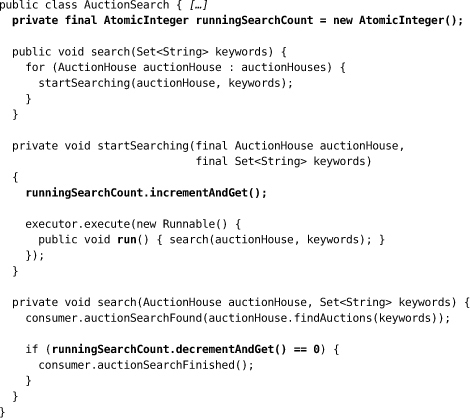
We try this and, in spite of our use of an AtomicInteger, our test still fails! We haven’t got our synchronization right after all.
We look again at the failure and see that now the AuctionSearch is reporting that the search has finished more than once per search. Previously, the unsafe concurrent access to runningSearchCount resulted in fewer auctionSearchFinished() notifications than expected, because AuctionSearch was losing updates to the field. Something else must be wrong.
As an eagle-eyed reader, you’ll have noticed a race condition in the way AuctionSearch increments and decrements runningSearchCount. It increments the count before starting a task thread. Once the main thread has started creating task threads, the thread scheduler can preëmpt it and start running whatever task threads are ready—while the main thread still has search tasks left to create. If all these started task threads complete before the scheduler resumes the main thread, they will decrement the count to ![]() and the last one will send an
and the last one will send an auctionSearchFinshed() notification. When the main thread finally resumes, it will continue by starting its remaining searches, which will eventually trigger another notification.
This sort of error shows why we need to write stress tests, to make sure that we see them fail, and to understand the failure messages—it’s also a good motivation for us to write comprehensible failure reports. This example also highlights the benefits of splitting tests of “raw” functionality from threaded tests. With the single-threaded version stable, we know we can concentrate on looking for race conditions in the stress tests.
We fix the code by setting runningSearchCount to the expected number of searches before starting any threads:
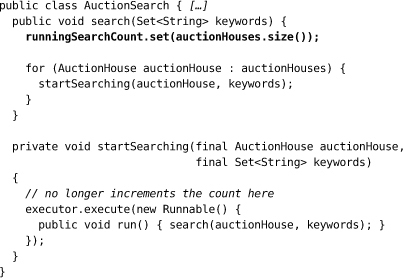
Stress-Testing Passive Objects
AuctionSearch actively starts multiple threads by calling out to its executor. Most objects that are concerned with threading, however, don’t start threads themselves but have multiple threads “pass through” them and alter their state. Servlets, for example, are required to support multiple threads touching the same instance. In such cases, an object must synchronize access to any state that might cause a race condition.
To stress-test the synchronization of a passive object, the test must start its own threads to call the object. When all the threads have finished, the state of the object should be the same as if those calls had happened in sequence. For example, AtomicBigCounter below does not synchronize access to its count variable. It works when called from a single thread but can lose updates when called from multiple threads:

We can show this failure by calling inc() from multiple threads enough times to give us a good chance of causing the race condition and losing an update. When this happens, the final result of count() will be less than the number of times we’ve called inc().
We could spin up multiple threads directly in our test, but the mess of detail for launching and synchronizing threads would get in the way of understanding the intent. The threading concerns are a good candidate for extracting into a subordinate object, MultiThreadedStressTester, which we use to call the counter’s inc() method:
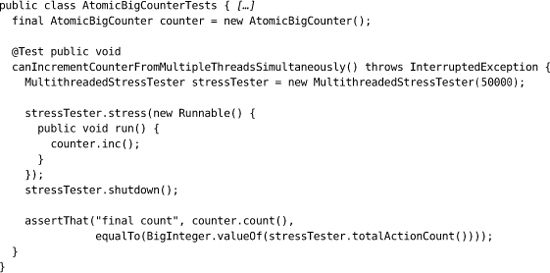
The test fails, showing the race condition in AtomicBigCounter:
![]()
We pass the test by making the inc() and count() methods synchronized.
Synchronizing the Test Thread with Background Threads
When writing a test for code that starts threads, the test cannot confirm the code’s behavior until it has synchronized its thread with any threads the code has started. For example, in AuctionSearchStressTests we make the test thread wait until all the task threads launched by AuctionSearch have been completed. Synchronizing with background threads can be challenging, especially if the tested object does not delegate to an executor to run concurrent tasks.
The easiest way to ensure that threads have finished is for the test to sleep long enough for them all to run to completion. For example:
![]()
This works for occasional use—a sub-second delay in a few tests won’t be noticeable—but it doesn’t scale. As the number of tests with delays grows, the total delay adds up and the test suite slows down so much that running it becomes a distraction. We must be able to run all the unit tests so quickly as to not even think about whether we should. The other problem with fixed sleeps is that our choice of delay has to apply across all the environments where the tests run. A delay suitable for an underpowered machine will slow the tests everywhere else, and introducing a new environment may force another round of tuning.
An alternative, as we saw in AuctionSearchStressTests, is to use jMock’s Synchroniser. It provides support for synchronizing between test and background threads, based on whether a state machine has entered or left a given state:
synchroniser.waitUntil(searching.is("finished"));
synchroniser.waitUntil(searching.isNot("in progress"));
These methods will block forever for a failing test, where the state machine never meets the specified criteria, so they should be used with a timeout added to the test declaration:
@Test(timeout=500)
This tells the test runnner to force a failure if the test overruns the timeout period.
A test will run as fast as possible if successful (Synchroniser’s implementation is based on Java monitors), and only wait the entire 500 ms for failures. So, most of the time, the synchronization will not slow down the test suite.
If not using jMock, you can write a utility similar to Synchroniser to synchronize between test and background threads. Alternatively, we describe other synchronization techniques in Chapter 27.
The Limitations of Unit Stress Tests
Having a separate set of tests for our object’s synchronization behavior helps us pinpoint where to look for defects if tests fail. It is very difficult to diagnose race conditions with a debugger, as stepping through code (or even adding print statements) will alter the thread scheduling that’s causing the clash.3 If a change causes a stress test to fail but the functional unit tests still pass, at least we know that the object’s functional logic is correct and we’ve introduced a defect into its synchronization, or vice versa.
3. These are known as “Heisenbugs,” because trying to detect the bug alters it.
Obviously, stress tests offer only a degree of reassurance that code is thread-safe, not a guarantee. There may be scheduling differences between different operating systems (or versions of an operating system) and between different processor combinations. Further, there may be other processes on a host that affect scheduling while the tests are running. The best we can do is to run the tests frequently in a range of environments—locally before committing new code, and on multiple build servers after commit. This should already be part of the development process. We can tune the amount of work and number of threads in the tests until they are reliable enough at detecting errors—where the meaning of “enough” is an engineering decision for the team.
To cover our backs, we take a “belt and braces” approach.4 We run unit tests to check that our objects correctly synchronize concurrent threads and to pinpoint synchronization failures. We run end-to-end tests to check that unit-level synchronization policies integrate across the entire system. If the concurrency architecture is not imposed on us by the frameworks we are using, we sometimes use formal modeling tools, such as the LTSA tool described in [Magee06], to prove that our concurrency model avoids certain classes of errors. Finally, we run static analysis tools as part of our automated build process to catch further errors. There are now some excellent practical examples, such as Findbugs,5 that can detect synchronization errors in everyday Java code.
4. For American readers, this means “belt and suspenders,” but suspenders are a significantly different garment in British English.
In this chapter, we’ve considered unit-level testing of concurrent code. Larger-scale testing of concurrent behavior is much more complex—the tested code might be running in multiple, distributed processes; the test setup might not be able to control the creation of threads with an executor; some of the synchronization events might not be easily detectable; and, the system might detect and swallow errors before they can be reported to a test. We address this level of testing in the next chapter.
